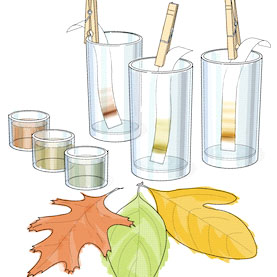Find the Hidden Colors of Autumn Leaves

Have you ever wondered why leaves change from green to an amazing array of yellow, orange and red during the fall? Leaves get their brilliant colors from pigments made up of various size, color-creating molecules.
During the warm, sunny months, plants use their leaves to turn sunlight into food energy, a process called photosynthesis. This primarily uses a pigment that reflects green light, which gives the leaves their characteristic color.
In autumn, when colder, shorter days arrive, many kinds of trees no longer make food energy with their leaves and, consequently, no longer need the green pigment. The leaves" other pigments, some of which were already there during summer, become visible. Uncover these hidden colors of fall by separating plant pigments with a process called paper chromatography. What colors will you see?
There are many types of pigments in plant leaves. Chlorophyll makes them green and helps carry out photosynthesis during warm, sunny months. As fall arrives and the green, food-making color fades, other pigments such as yellow, orange and red ones become more visible.
Xanthophylls are yellow pigments, and carotenoids give leaves an orange color. Photosynthesis also uses these pigments during the summer, but chlorophyll, a stronger pigment, overpowers them. These pigments take more time to break down than chlorophyll does, so you see them become visible in fall leaves. They're also found in carrots, daffodils, bananas and other plants that have these vibrant colors.
There are also anthocyanins, intense red pigments that aren't made during the summer, only appearing with the final group of the fall colors. These molecules also give the red hue to apples, cranberries, strawberries and more.
Although a leaf is a mixture of these pigments, you can separate the colors using a method called paper chromatography. This process dissolves the pigments and allows them to be absorbed by a strip of paper. Larger molecules have a harder time moving in the woven paper and get trapped in the paper first, whereas smaller ones travel farther along the paper. This process separates the mixture of pigments by molecular size—and by color.
熱門推薦:
考研網(wǎng)校哪個好
新東方考研培訓(xùn)班
考研培訓(xùn)班
考研培訓(xùn)機構(gòu)哪個好
考研英語網(wǎng)絡(luò)課程
文都考研網(wǎng)校
北京考研培訓(xùn)班

